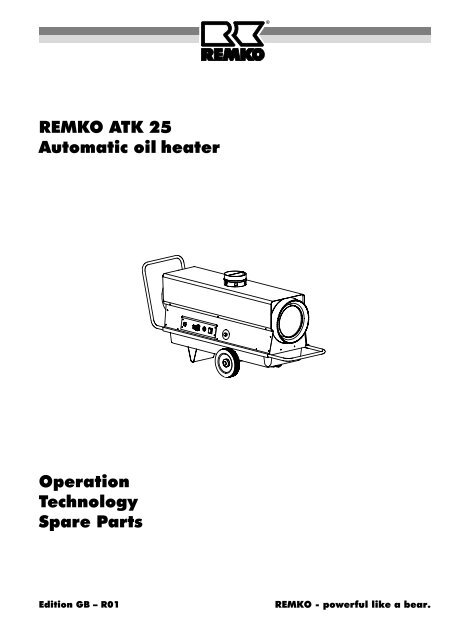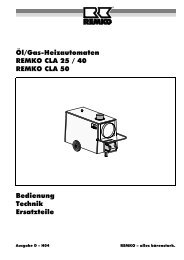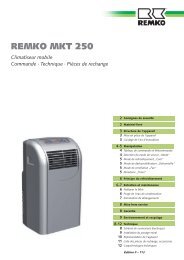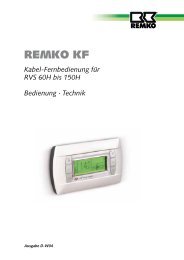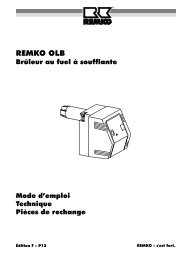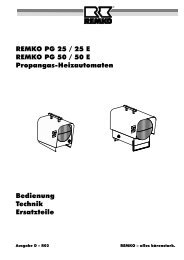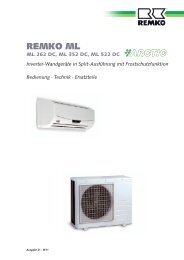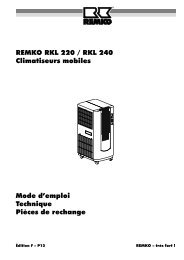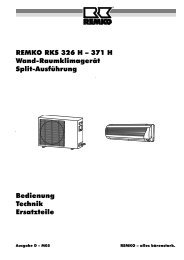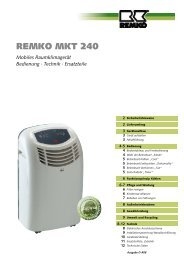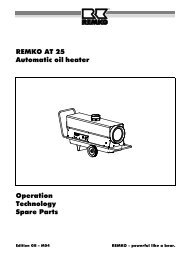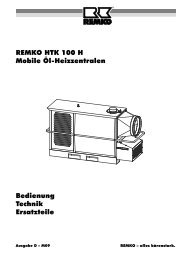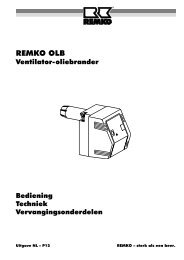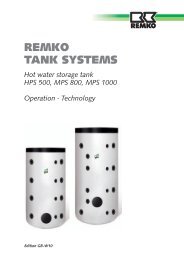Create successful ePaper yourself
Turn your PDF publications into a flip-book with our unique Google optimized e-Paper software.
REMKO <strong>ATK</strong> <strong>25</strong><br />
Automatic oil heater<br />
Operation<br />
Technology<br />
Spare Parts<br />
Edition <strong>GB</strong> – <strong>R01</strong><br />
REMKO - powerful like a bear.
Make sure to read these instructions carefully before starting/using the unit!<br />
Our guarantee will become void when the unit supplied by us is used and<br />
installed for inadequate purposes, or maintained incorrectly, etc.,<br />
or if it is changed without our prior consent.<br />
Subject to alterations!<br />
Contents Page<br />
Safety Instructions 4<br />
Description of device 4<br />
Provision of air heaters 5<br />
Installation Requirements 6<br />
Exhaust system 6<br />
Starting 7<br />
Unit shut down 7<br />
Maintenance and service 8<br />
Exhaust measurement 9<br />
� Always<br />
Operating Instructions<br />
Automatic oil heater<br />
REMKO <strong>ATK</strong> <strong>25</strong><br />
Contents Page<br />
Service and Guarantee 9<br />
Fuel pump 10<br />
Technical data 10<br />
Wiring diagram 10<br />
Troubleshooting 11<br />
Exploded view 12<br />
Spare part list 13<br />
Maintenance log 14<br />
keep these operating instructions near or on the unit! �<br />
3
Safety Instructions<br />
Please make sure that the relevant local building<br />
and fire protection codes as well as the regulations<br />
of the employer's liability insurance associations<br />
are observed when the units are used.<br />
◊ The units may be operated only by persons who<br />
have been trained in this field.<br />
◊ The unit is to be installed and operated in such a<br />
way as to ensure that the employees are not endangered<br />
by waste gases and radiation heat and that no<br />
fire can break out.<br />
◊ The unit may only be installed and operated in<br />
rooms, when the air-rate fed to the unit is sufficient<br />
for combustion.<br />
◊ Without an exhaust system, the unit may only be operated<br />
in well aerated rooms. The permanent stay of<br />
persons in the room where the units are installed is<br />
prohibited.<br />
Appropriate prohibition signs are to be fitted at the<br />
entrances.<br />
◊ Mobile fuel reservoirs may be installed only when<br />
the technical rules for combustible liquids are observed.<br />
◊ The unit is to be installed only on a non-combustible<br />
ground.<br />
◊ The unit may not be installed and operated in inflammable<br />
and explosive surroundings.<br />
◊ A safety zone of 1.5 m around the unit, as well as a<br />
minimum distance of 3 m from the unit's blower aperture<br />
is to be maintained, even in the case of non<br />
combustible objects.<br />
◊ The protective air suction grille is always to be kept<br />
free from dirt and loose objects.<br />
◊ Make sure not to introduce foreign matters into the<br />
unit.<br />
◊ Make sure not to expose the unit to direct water jets.<br />
◊ All electric cables outside the unit are to be protected<br />
from damage (e.g. caused by animals, etc.).<br />
◊ Make sure always to pull the mains plug out of the<br />
mains socket when maintenance and repairs are<br />
carried out.<br />
�<br />
�<br />
4<br />
During the unit’s operation, safety devices may<br />
neither be bridged nor blocked!<br />
On account of the construction type, a fixedlocation<br />
device installation is not permissible!<br />
Description of Device<br />
The unit is fired directly with heating oil EL or diesel and<br />
can be operated with or without an exhaust-gas connection.<br />
It is intended for mobile and fully automatic deployment.<br />
A fuel container is built under the unit and it is equipped<br />
with automatic tank heating, a high-pressure atomizing<br />
oil burner with optical flame monitoring, a low maintenance<br />
axial ventilator, a connection cable with plug, a<br />
room thermostat socket and a fourfold filter system.<br />
The unit complies with the basic safety and health requirements<br />
of the relevant EU stipulations and is reliable<br />
and simple to operate.<br />
The unit can be used e.g. in the following areas:<br />
- for drying new buildings;<br />
- for point heating of outdoor workplaces;<br />
- for point heating of workplaces in open, non firehazard<br />
fabrication rooms and halls;<br />
- for temporary heating of closed and open areas;<br />
- for de-icing of machines, vehicles and non flammable<br />
storage goods;<br />
- for tempering frost-endangered parts.<br />
Working of Device<br />
When the power plug is connected to a power socket,<br />
the automatic tank heater is activated for temperatures<br />
below 10 °C.<br />
When the unit has been switched on or when heat is<br />
required (automatic function with room thermostat) the<br />
supply air fan starts. The fan blows air into and along<br />
the combustion chamber.<br />
When the preliminary ventilation is over, the electromagnetic<br />
valve opens and supplies fuel to the nozzle.<br />
The fuel, sprayed under high pressure, is enriched by<br />
an adequate quantity of oxygen according to the heating<br />
capacity and ignited by an electric spark. Once a<br />
flame is burning, the automatic burner relay begins<br />
monitoring the flame.<br />
The automatic burner relay controls all unit functionality<br />
fully automatically and monitors them for safety.<br />
After a few seconds hot air is blown out.case of any<br />
troubles, or if the flame is unstable or tends to go out,<br />
the unit is switched off by the automatic burner relay.<br />
The fault indicator warning lamp of the automatic burner<br />
relay lights up. A restart cannot be made before the<br />
manual release of the automatic burner relay.<br />
When the unit has been switched off via the operating<br />
switch or the room thermostat, the supply air fan continues<br />
running for some time to cool down the combustion<br />
chamber and then it stops automatically.<br />
Depending on the required heat rate the function described<br />
above is repeated automatically in the case of<br />
an operation with thermostat.<br />
For optimum unit operation, the device should not<br />
� be operated at an ambient temperature above <strong>25</strong> °C.
Safety temperature limiter (STB)<br />
The STB interrupts the supply of fuel if the unit overheats<br />
and causes the automatic burner relay to switch<br />
off.<br />
If the safety temperature limiter has triggered, the<br />
cause of the disturbance must first be localised and<br />
eliminated. Resetting via the "RESET" key is only possible<br />
after the sensor has cooled to below ca. 90 °C.<br />
The safety temperature limiter is unlocked by pressing<br />
the reset key.<br />
1 2<br />
1. Detach the protection cap 1.<br />
2. Press the reset key 2.<br />
3. Replace the protection cap.<br />
4. Release the automatic burner relay<br />
as well.<br />
Provision for Air Heaters<br />
For the deployment of the unit, the relevant guidelines<br />
must be observed<br />
1. Operating personnel<br />
1.1 The unit must only be operated by persons who<br />
have been trained in its operation.<br />
2. Installation<br />
2.1 The unit must be installed so that it can stand in a<br />
stable position.<br />
2.2 The unit must be installed and operated in such a<br />
way that the employees are not exposed to the<br />
danger of exhaust gases and radiant heat and that<br />
the occurrence of fires is ruled out.<br />
2.3 The unit may only be installed and operated in<br />
rooms if a quantity of air sufficient for the combustion<br />
is supplied to the unit and the exhaust gases<br />
are removed to the exterior.<br />
A natural air supply sufficient for the combustion is<br />
present if e.g.<br />
The room contents in m² correspond with at<br />
least 10 times the nominal heat load in kW of all<br />
the units operating in the room and if windows<br />
and doors ensure a natural change of air.<br />
2.4 In deviation from point 2.3, the unit can be operated<br />
without an exhaust system in rooms if these<br />
rooms have a sufficient air supply and are well<br />
ventilated and if materials harmful to health do not<br />
reach an unhealthy concentration.<br />
2.5 A good natural air supply and ventilation is the<br />
case if e. g.<br />
The room contents in m² correspond with at least<br />
30 times the nominal heat output of all units operating<br />
in the room and a natural change of air is ensured<br />
through windows and doors, or<br />
openings which are not lockable are present in the<br />
region of ceiling and floor for the air supply and for<br />
out going air and the size of these openings in m²<br />
corresponds with at least 0.003 times the nominal<br />
heat output in kW of all units operating in the room.<br />
2.6 The unit must not be installed or operated in rooms<br />
and areas where the danger of fire or explosion exists.<br />
3. Room drying<br />
3.1 In deviation from point 2.3, in order to dry rooms<br />
with an air supply sufficient for the combustion,<br />
heating units can be operated without the exhaust<br />
gases being removed to the exterior. In these<br />
rooms, the permanent presence of persons is forbidden.<br />
Signs on the entrances to the rooms must<br />
indicate that this is forbidden.<br />
4. Examination<br />
4.1 The unit must be tested by an expert as to its work<br />
safety specific condition in accordance with the required<br />
deployment conditions but at least once annually.<br />
4.2 The exhaust values of the burner must be<br />
checked.<br />
5. Monitoring<br />
5.1 When starting work, the persons commissioned<br />
with the operation of the unit must check the unit<br />
for obvious defects or deficiencies on the operational<br />
and safety mechanisms and check that the<br />
safety mechanisms are present.<br />
5.2 If defects or deficiencies are discovered, the supervisor<br />
must be informed.<br />
5.3 In the case of defects or deficiencies which en danger<br />
the operational safety of the unit, its operation<br />
must be terminated.<br />
6. Installation in closed, well aerated rooms without<br />
connection to a chimney<br />
6.1 The operation of the units is admissible when the<br />
minimum air quantity needed for combustion and<br />
mentioned in point 2.5 is supplied.<br />
6.2 A safe exhaustion of the waste gases is to be ensured<br />
to exclude inadmissible pollution.<br />
Fresh air is fed from below;<br />
waste gases are exhausted towards the top.<br />
7. Correct usage<br />
7.1 The unit are to be used only for heating purpose in<br />
industrial or commercial application because of their<br />
construction and equipment.<br />
7.2 If specification of the manufacturer or legal regulations,<br />
are not followed or if unauthorised changes<br />
are made on the unit, the manufacturer is not liable<br />
for resulting damages.<br />
5
Installation Requirements<br />
The heaters may only be installed in compliance with<br />
the relevant regulations, in particular, regulations governing<br />
the installation and operation of fireplaces and<br />
furnaces.<br />
Any national/regional emission control laws or regulations<br />
must also be observed.<br />
Electrical Connection<br />
◊ The units are operated with 230 V / 1~ N / 50 Hz.<br />
◊ The unit must be connected to the power source at a<br />
special terminal equipped with a switch to protect<br />
against faulty currents.<br />
Outside installation<br />
◊ Operation of the unit may not have any harmful effects<br />
or cause any unreasonable problems.<br />
◊ The unit operator must ensure that unauthorised<br />
persons are prevented from manipulating the unit or<br />
its power supply.<br />
◊ Because rain and snow can be sucked in by the air<br />
supply fan, a suitable protective covering should be<br />
used.<br />
Installation in closed, well aerated rooms without<br />
connection to a chimney<br />
◊ The units may only be operated when the minimum<br />
amount of air required for combustion is supplied.<br />
◊ A safe exhaustion of the waste gases is to be ensured<br />
to exclude inadmissible pollution.<br />
- Fresh air is supplied from below.<br />
- Waste gases are expelled upwards.<br />
Heating Rooms<br />
◊ Warm air generators may only be operated with a<br />
room thermostat when heating rooms.<br />
Accessories.<br />
◊ Make sure that sufficient fresh air is fed to ensure<br />
perfect combustion. Fresh air is to be fed preferably<br />
through windows and doors or through sufficiently<br />
dimensioned openings in the outer wall.<br />
Safety zones<br />
◊ To ensure safe operation and guarantee unhindered<br />
access to the unit for maintenance work, a safety<br />
zone of 1.5 m should be maintained around the unit.<br />
◊ Floors and ceilings must be fire-resistant.<br />
�<br />
6<br />
Avoid under or overpressure in the room where<br />
the unit is installed, as this would result in combustion<br />
troubles.<br />
Exhaust system<br />
In the outdoors or in open rooms, the operation of the<br />
device is also possible without an exhaust system.<br />
However, we recommend a 1 m exhaust-pipe (see example<br />
2) with a rain hood placed on top so as to rule<br />
out the penetration by rainwater and dirt.<br />
If the device is used for temporary room heating, the<br />
combustion gases may have to be removed to the exterior.<br />
The exhaust-pipe parts must be laid in such a way<br />
that a minimum suction of 0.1 mbar is guaranteed.<br />
�<br />
It must be made sure in all cases that counter<br />
pressure due to an incorrect exhaust system is<br />
ruled out.<br />
Malfunction-free operation is guaranteed if the exhaust<br />
system is installed in an ascending direction and with<br />
vertical end pipes.<br />
The exhaust system must terminate at least above the<br />
height of the eaves but better still above roof height in<br />
order to avoid counter pressure caused by weatherrelated<br />
circumstances (e.g. wind).<br />
All exhaust-pipe parts must be attached reliably. Their<br />
diameter must not be smaller than that of the exhaust<br />
nozzle of the device (∅ 150 mm).<br />
The minimum distance of 0.6 m to combustible parts<br />
must not be exceeded.<br />
Exhaust-pipe parts including attachment material are<br />
available as accessories.<br />
Example 1 Example 2 Example 3<br />
operating with<br />
extended<br />
waste gas pipe<br />
condensate trap<br />
necessarily<br />
max.1 m.<br />
operating without<br />
extended<br />
waste gas pipe<br />
max. 1m<br />
more than 1 m.<br />
Inadmissible<br />
arrangement.<br />
Important hint.<br />
Make sure that the waste gas pipes are correctly installed<br />
with a condensate trap (see example 1), to avoid<br />
damage to the combustion chamber through humidity<br />
deposits (condensate) (see example 3).<br />
The lateral openings in the exhaust connection must<br />
not be closed or covered.
Starting<br />
Prior to starting, the unit is to be checked to make sure<br />
that there are no visible defects on the control and<br />
safety devices, that the unit has been installed correctly<br />
and that it has been properly connected to the mains.<br />
A properly trained person is to be charged with the operation<br />
and control of the unit.<br />
◊ Install unit in a stable position.<br />
◊ Make sure that combustion air is supplied.<br />
◊ Make sure that the air can be sucked in and be exhausted<br />
freely.<br />
◊ Avoid overpressure and underpressure in the room<br />
where the unit has been installed.<br />
◊ Make sure that enough fuel is supplied.<br />
◊ Fill fuel tank only with clean fuel oil EL or diesel with<br />
the unit switched off.<br />
Do not use biodiesel.<br />
◊ Use only appropriate and clean tanks to fill with fuel.<br />
◊ Possibly required extension cables must be selected<br />
according to the existing cable length, the unit’s connecting<br />
line and the intended purpose.<br />
◊ All extension cables are to be used only after having<br />
been removed from the roller.<br />
�<br />
The waste gas values of the oil-burner are to be<br />
checked and properly adjusted by authorised personnel<br />
to ensure compliance with local requirements<br />
Paraffin accumulation by low outside temperatures<br />
The supply of sufficient liquid fuel is to be ensured,<br />
even with low outside temperatures.<br />
�<br />
Paraffin accumulation can occur even at temperatures<br />
as low as 5 °C. Appropriate measures must<br />
be taken to avoid this. (winterised heating oil)<br />
◊ The built-in tank heating is only active as long as the<br />
mains plug is connected with a functioning mains<br />
socket and the surrounding temperature is below<br />
10 °C.<br />
◊ It is not possible to get rid of paraffin discharge<br />
which is already present using the tank heating.<br />
The requirement for this is the cleaning of the entire<br />
fuel system.<br />
Fuel filter<br />
Prior to commissioning the unit and before<br />
the tank is filled each time, the main filter (F)<br />
must be checked for the presence of grime<br />
or the accumulation of paraffin.<br />
The main filter is positioning beside the filler.<br />
Make sure to fill the fuel tank only with the<br />
tank filter inserted into the filler neck.<br />
F<br />
Connect the unit with the current supply<br />
Heating without a room thermostat<br />
The unit runs in continuous operation.<br />
2 3<br />
5<br />
1. Put operating switch 1 into “0”<br />
position (OFF).<br />
2. Connect unit plug to a suitable<br />
mains socket.<br />
230V / 1~ / 50 Hz.<br />
1. Plug the supplied bridge circuit plug<br />
2 into the thermostat socket 3.<br />
2. Set the operating switch to “I“ (ON).<br />
Fully automatic heating with room thermostat<br />
The unit runs fully automatically with the temperature<br />
which has been pre-selected on the room thermostat.<br />
4 3<br />
1. Remove the bridge circuit plug 2.<br />
2. Plug the thermostat plug 4 of the<br />
room thermostat (accessories) into<br />
the thermostat socket 3.<br />
3. Put room thermostat 5 in a suitable<br />
place.<br />
The thermostat sensor may not be<br />
placed directly in the warm air<br />
stream or attached to a cold surface.<br />
4. Pre-select desired room temperature<br />
on the room thermostat.<br />
5. Set the operating switch to “I” (ON).<br />
When heat is required, the forcedair<br />
burner switches on automatically;<br />
operation of the unit is fullyautomatic.<br />
Unit Shut Down<br />
1. Set the operating switch to “0” (ON).<br />
2. Shut off the fuel supply.<br />
Important information about the cool-down phase<br />
The air supply fan continues running to cool down the<br />
combustion chamber and then stops at a later time. The<br />
fan can run several times before the unit is finally<br />
switched off.<br />
Never interrupt (except in emergency situations)<br />
the power supply until the cool-down phase is<br />
completely finished. � Our guarantee does not cover damages caused to<br />
the unit by overheating.<br />
7
Maintenance and Service<br />
The unit is to be maintained regularly whereby some<br />
fundamental rules are to be observed to ensure a long<br />
service life and trouble-free operation.<br />
After each heating period or even earlier, depending on<br />
the deployment conditions, the entire unit including<br />
combustion chamber and burner head must be cleaned<br />
of soot sediments, dust and dirt.<br />
The oil filters must also be cleaned / replaced at least<br />
once a year or, depending on the degree of contamination<br />
of the fuel, frequently.<br />
�<br />
�<br />
◊ The unit is to be kept free from dust and other deposits<br />
and is to be cleaned only with a dry or humid cloth.<br />
Do not use water jet.<br />
◊ Do not use any aggressive cleaning agents or those<br />
which are harmful or environmentally unfriendly.<br />
◊ Use only clean fuel oil EL and diesel, respectively.<br />
Make sure to avoid paraffin formation.<br />
◊ Empty fuel tank at least twice a year and rinse it with<br />
clean fuel.<br />
Do not use water.<br />
◊ Keep burner head clean.<br />
◊ Wearing parts such as e.g. oil filters, burner nozzle<br />
and gaskets must be checked and, if necessary, replaced.<br />
In any case, we recommend the replacement of the<br />
oil nozzle before the start of each heating season.<br />
◊ The oil filter in the filler neck of the fuel tank is to be<br />
cleaned regularly.<br />
◊ The main oil filter is to be replaced (take care of flow<br />
direction) depending on the rate of pollution, but at<br />
least before the start of every heating period.<br />
The main filter is at the left side of the unit above the<br />
fuel tank.<br />
◊ Only have the gauze filter in the fuel pump cleaned<br />
and the burner nozzle replaced by authorised service<br />
personnel.<br />
◊ Check safety devices regularly.<br />
◊ In the case of reducing heating capacity, formation<br />
of smoke and/or bad ignition the unit is to be inspected<br />
and the burner is to be adjusted.<br />
◊ Observe regular maintenance and care intervals.<br />
8<br />
Prior to starting any work make sure to pull the<br />
mains plug out of the mains socket! There is extreme<br />
risk of injury especially when the unit lining<br />
is open from the fan that switches on automatically.<br />
Setting and maintenance is to be carried out<br />
only by authorised personnel!<br />
Cleaning the burner<br />
Clean the components of the burner as described below:<br />
1. Pull the photocell 1 from its mount.<br />
2. Remove both ignition cables 2.<br />
3. Loosen the swivel nuts 3 of the fuel line from the<br />
nozzle mount.<br />
Fuel may leak out.<br />
4. Loosen the swivel nuts of the fuel line on the fuel<br />
pump and rotate the fuel line carefully to the side.<br />
5. Remove both attachment screws of the assembly<br />
plate 4 and remove the burner from the burner<br />
chamber.<br />
6. Clean the spark plugs, the oil nozzle, the air flow<br />
plate and the opening for light 5.<br />
�<br />
1<br />
Only use suitable tools to take apart the burner<br />
nozzle and apply counter-pressure on the nozzle<br />
connection rod !<br />
7. Check the spark plug settings to ensure that they<br />
match the guideline values.<br />
8. Make sure that opening 5 is not overshadowed by<br />
the air flow plate.<br />
Attachment screw of the air flow plate above and between<br />
the spark plugs.<br />
9. After service work, reassemble all parts again carefully<br />
in the reverse order.<br />
Adjustment values of the spark plugs<br />
All measurements are guidelines in mm.<br />
2<br />
3<br />
3<br />
Adjusting the air slide plate<br />
The air slide plate is set at the factory. The air throughput<br />
may only be adjusted to local conditions by authorised<br />
personnel.<br />
After the clamp screw is a loosened, the air slide plate<br />
can be adjusted using the exhaust measurement.<br />
CO2 - value: approx. 11 - 12 %;<br />
Soot number: 0 - 1 lt. Bacharach<br />
7<br />
4<br />
7<br />
5
Cleaning the fuel tank<br />
It is necessary to clean the fuel tank:<br />
◊ After each heating period or, depending on the<br />
deployment conditions, even earlier.<br />
◊ Before and after extended idle periods.<br />
◊ If the main filter frequently becomes dirty.<br />
◊ If condensation water accumulates in the fuel.<br />
Please proceed in the following way when cleaning the<br />
fuel tank:<br />
1. Unscrew the discharging screw D and discharge the<br />
fuel into a suitable vessel.<br />
2. Rinse the container several times if necessary with<br />
clean fuel thoroughly.<br />
Do not use water!<br />
3. Please use no cleaning agents which contain<br />
solvents.<br />
These can destroy the inner layer of the tank.<br />
4. Avoid the use of high-pressure cleaners.<br />
5. Fit the discharging screw D.<br />
The gasket ring E should be replaced after each<br />
disassembly.<br />
6. Fill tank with clean fuel.<br />
Do not use biodiesel<br />
7. Start unit and let it run for approx. 3 minutes.<br />
�<br />
After maintenance work is complete, conduct an<br />
electrical safety test.<br />
Exhaust Measurement<br />
On account of the construction-dependent design of the<br />
exhaust connection (connection nozzle with secondary<br />
air openings), it is not possible to perform a correct exhaust<br />
analysis in a conventional manner in the exhaust<br />
pipe behind the exhaust connection.<br />
For the performance of the exhaust analysis the sensor<br />
of the exhaust-measurement device must be placed in<br />
the centre of the pipe socket of the heat exchanger.<br />
E<br />
D<br />
The measurement sensor is placed through the appropriate<br />
lateral secondary air opening in the exhaust connection<br />
in the existing measurement opening in the pipe<br />
nozzle of the combustion chamber (see drawing below).<br />
Drawing top-view<br />
�<br />
measurement<br />
sensor<br />
pipe socket<br />
measurement<br />
opening<br />
exhaust<br />
connection<br />
exhaust<br />
connection<br />
pipe socket<br />
measurement<br />
sensor<br />
auxiliary air<br />
opening<br />
Service and Guarantee<br />
For the guarantee to be valid, the customer must completely<br />
fill out the “guarantee certificate” enclosed with<br />
all heating units and send it back to REMKO GmbH &<br />
Co. KG in a timely manner after purchasing of the unit<br />
and putting it into operation.<br />
The units have undergone several tests to ensure<br />
proper functioning at the factory. If there are still malfunctions<br />
that cannot be fixed by the operator using the<br />
troubleshooting instructions, please contact your dealer<br />
or contract partner.<br />
An operation/use other than indicated in these instructions<br />
is prohibited!<br />
In the case of non-compliance, we assume no liability<br />
and our guarantee becomes null and void.<br />
Proper Use<br />
The units are to be used only for heating purpose in industrial<br />
or commercial application because of their construction<br />
and equipment.<br />
The manufacturer is not liable for any damage resulting<br />
from non-adherence to manufacturer specifications, legal<br />
requirements or any modifications to the units.<br />
9
Fuel Pump<br />
The standard type of the pump runs in a system of<br />
1 pipe. The required fuel is sucked in through the suction<br />
line "S".<br />
For the first starting and after having emptied the fuel<br />
tank, the fuel system is deaerated through the burner<br />
nozzle. For this purpose the unit is switched on. After a<br />
possible switch off through failure, the unit is restarted<br />
after having released the automatic burner relay (take<br />
care of waiting time).<br />
If, after the 3rd start of the unit there is another switch<br />
off through faults, the fuel filters should be checked to<br />
make sure that they are free from pollutions and that<br />
they are tight.<br />
Setting the pump pressure<br />
The pump pressure can<br />
only be set if a manometer<br />
is connected to the connection<br />
P.<br />
The pump pressure is<br />
changed by turning the<br />
pressure setting screw A.<br />
Clockwise:<br />
increase the pressure<br />
counter clockwise:<br />
reduce the pressure<br />
The required pump pressure<br />
is determined according<br />
to the heating capacity<br />
(please refer to unit type<br />
plate) and to the nozzle size.<br />
�<br />
�<br />
Cleaning the cartridge filter<br />
Regularly clean the cartridge filter B of the fuel pump<br />
and replace it as necessary.<br />
1. Turn the plug C with a<br />
hexagonal wrench and<br />
C<br />
take it out of the pomp at<br />
the top.<br />
2. Carefully pull the cartridge<br />
filter B out of the plug.<br />
3. Clean or replace the filter.<br />
4. Press the filter back onto<br />
the plug and screw both<br />
of them back into the<br />
pump.<br />
B<br />
10<br />
Perfect fuel quality is an absolute necessity for the<br />
lubrication of the pump drive.<br />
Suction of water residues should never take place<br />
and, in the case of setting, suction should not take<br />
place of warping fine dusts (e.g. cement etc.).<br />
Never let the pump run without feeding fuel for a<br />
longer period. Make sure not to leave a unit with<br />
dry run pump unattended for a longer time.<br />
A<br />
S<br />
P<br />
Technical Data<br />
Model <strong>ATK</strong> <strong>25</strong><br />
Nominal heat output max. kW <strong>25</strong>,00<br />
Nominal heat output kW 22,50<br />
Air output m³/h 1080<br />
Increase of temperature ∆t K 70<br />
Fuel Heating oil EL or Diesel<br />
Fuel consumption, max. l/h 2,4<br />
Nozzle (Danfoss) 0,50 GPH 80° H<br />
Pump pressure approx. bar 11 bis 12<br />
Tank capacity Ltr. 40<br />
Electrical connection 1~ V / Ph 230 / 1~, N, PE<br />
Frequency Hz 50<br />
Rated current max. A 2,3<br />
Power consumption max. 1) kW 0,43<br />
Fuse protection (required) A 10<br />
Sound pressure level LpA 1m 2) dB(A) 74<br />
Exhaust connection ø mm 150<br />
Length mm 1265<br />
Width mm 470<br />
Height mm 685<br />
Weight kg 68<br />
1) unit inclusive tank heating<br />
2) noise measuring (when heating) DIN 45635 - 01 KL 3<br />
Wiring Diagram<br />
STB<br />
1<br />
F<br />
ϑ<br />
2<br />
MV<br />
3<br />
4<br />
5<br />
S 2 3<br />
THZ<br />
L N PE<br />
C = capacitor<br />
F = fuse<br />
FZ = photo cell<br />
M = motor<br />
MV = solenoid valve<br />
NK = recool thermostat<br />
RS = relay socket<br />
S = operating switch<br />
ϑ<br />
FZ<br />
TS<br />
6<br />
NK<br />
blue blau<br />
RS<br />
brown braun<br />
7<br />
white<br />
weiß<br />
ϑ<br />
8<br />
M<br />
9<br />
C<br />
10<br />
ZE<br />
ZT<br />
11<br />
1 2 3 4 5 6 7 8 N 9<br />
12<br />
STB = safety temperaturelimiter<br />
THZ = tank heating with<br />
thermostat<br />
TS = thermostat socket<br />
ZE = ignition electrode<br />
ZT = ignition transformer
Troubleshooting<br />
Cause: Remedy:<br />
1. Air (bubbles) in the fuel system during starting procedure.<br />
– Press fault clearance button of the automatic burner relay,<br />
repeat if necessary (max. 3 x).<br />
2. No electrical connection. – Check mains, mains plug and current.<br />
3. No (bridge circuit-/thermostat-) plug in the thermostat socket.<br />
– Connect bridge circuit plug resp. thermostat plug with the thermostat<br />
socket.<br />
4. Thermostat setting is too low. – Set thermostat higher than the room temperature.<br />
5. Fault indicator lamp of the automatic burner relay lights up. – Unlock the automatic burner relay by pressing the reset button.<br />
6. Faults in the automatic burner relay. – Replace automatic burner relay.<br />
7. Fan motor is overcharged.<br />
(Fan blows irregularly or is blocked).<br />
– Let motor cool down.<br />
– Check slight run of fuel pump.<br />
– Check motor on electrical and mechanical function.<br />
8. Fuel pump is blocked. – Check resp. replace fuel pump.<br />
9. Fuel tank is empty. – Fill fuel tank with clean fuel.<br />
10. Fuel filter is blocked (dirty). – Clean fuel filter resp. replace if necessary.<br />
11. Nozzle is blocked resp. wrong dimension (type/size). – Replace nozzle (take care of correct type and size!).<br />
12. Wrong setting of ignition electrodes or damaged insulation. – Adjust correctly resp. replace it.<br />
13. Air flow plate of the burner head is misadjusted resp. dirty.<br />
14. Solenoid valve does not open.<br />
– Adjust correctly by means of CO2 –indicator and soot pump<br />
(CO2: 11 – 12 %, soot figure by Bacharach: 0 – 1).<br />
– Check solenoid valve resp. replace if necessary.<br />
– The safety temperature limiter has released / is defective.<br />
15. Misadjusted pump pressure. – Set pump pressure by means of a pressure-gauge.<br />
16. Pump clutch is defective. – Replace pump clutch.<br />
17. Leakage in suction pipe or in fuel filter. – Check suction pipe and fuel filter, replace if necessary.<br />
18. Solenoid valve does not close. – Pull off the fuel pipe from the main filter - the flame dies.<br />
19. Air protecting grille is dirty. – Clean air protecting grille.<br />
20. Disconnection by the safety temperature limiter (STB).<br />
21. Air (bubbles) in the fuel system.<br />
Trouble: Cause:<br />
Fan motor does not start 2 – 3 – 4 – 6 – 7 – 8 – <strong>25</strong><br />
Fan motor is running but burner will not be ignited.<br />
Unit shut down without flaming formation.<br />
Unit stops during operation.<br />
(fault indicator lamp of the automatic burner relay lights up)<br />
– Check air protecting grille, clean if necessary.<br />
– Release the STB and the automatic burner relay.<br />
22. No adequate ventilation. – Open doors or windows.<br />
– Restart the unit in order to discharge the air through the nozzle.<br />
(This procedure can be repeated up to max. 3 times).<br />
23. Photo cell is dirty resp. defective. – Clean photo cell resp. replace if necessary.<br />
24. Improper exhaust system. – See chapter “Exhaust system“.<br />
<strong>25</strong>. Operating switch not functioning. – Check operating switch resp. replace if necessary.<br />
26. Fuel with paraffin accumulation.<br />
(Already occur starting from 5 °C see notes in chapter "Starting").<br />
The tank heating is damage (very rarely).<br />
1 – 5 – 6 – 9 – 10 – 11 – 12 – 13 – 14 – 15 – 16 – 17<br />
20 – 21 – 23 – 24 – 26<br />
4 – 5 – 6 – 7 – 8 – 9 – 10 – 11 – 13 – 15 – 16 – 17<br />
19 – 20 – 21 – 22 – 23 – 24 – 26<br />
Smoke forming at the blow-out cone 7 – 10 – 11 – 13 – 15 – 17 – 19 – 21 – 22 – 24<br />
Unit can’t be switched off 18 – <strong>25</strong><br />
The mains plug has been taken out of the mains socket before carrying out any work regarding the unit.<br />
� Setting and maintenance is to be carried out only by authorised experts! �<br />
– Clean the entire fuel system.<br />
– Replace the damage tank heating.<br />
11
Exploded View<br />
26<br />
51<br />
12<br />
27<br />
28<br />
50<br />
52<br />
15<br />
63<br />
14<br />
48<br />
21<br />
49<br />
18<br />
16<br />
13<br />
22<br />
47<br />
17<br />
53<br />
45<br />
39<br />
12<br />
11<br />
23 24 <strong>25</strong><br />
29<br />
31<br />
46<br />
38<br />
See Siehe fig. A<br />
Abb. “A”<br />
56<br />
55<br />
85<br />
1<br />
44<br />
30<br />
43<br />
10<br />
34<br />
2<br />
9<br />
42<br />
8<br />
32<br />
38<br />
41 32<br />
62<br />
61<br />
60<br />
39<br />
38<br />
58<br />
39<br />
40 39<br />
We reserve the right to make modifications in dimensions and construction in the interests of technical progress.<br />
33<br />
59<br />
68<br />
34<br />
32<br />
66<br />
38<br />
67<br />
58<br />
15<br />
78<br />
55<br />
70<br />
69 73<br />
77<br />
64<br />
65<br />
79<br />
80<br />
81<br />
3<br />
4<br />
76<br />
4<br />
3<br />
85<br />
54<br />
75<br />
5<br />
56<br />
83<br />
35<br />
52<br />
71<br />
72<br />
74<br />
84<br />
Abb. Fig. “A” A<br />
57<br />
36<br />
37<br />
84
Spare Part List<br />
No. Description Ref-No.<br />
1 exhaust connection 1103702<br />
2 inspection cover 1103740<br />
3 inspection cover 1103703<br />
4 gasket (inspection cover) 1103705<br />
5 combustion chamber cpl. 1103741<br />
8 air slide plate 1103742<br />
9 air flow plate 1103743<br />
10 nozzle 1103744<br />
11 holder (nozzle) 1103745<br />
12 mounting plate 1103746<br />
13 ignition electrode 1103747<br />
14 protection hose 1103748<br />
15 ignition cable 1108574<br />
18 angle clutch 1103749<br />
21 photo cell 1108209<br />
22 photo cell holder 1301560<br />
23 recool thermostat, 3 terminal 1103750<br />
24 distance sleeve 1103751<br />
<strong>25</strong> clamp (thermostat) 1103752<br />
26 protecting grille 1103753<br />
27 mounting clip 1102906<br />
28 fan blade ∅ 300 18° 1103754<br />
29 fan housing 1103755<br />
30 air baffle plate, right 1103756<br />
31 air baffle plate, left 1103757<br />
32 protective socket ∅ 8 1102131<br />
33 housing base 1103758<br />
34 mounting clip 1102906<br />
35 blow-out cone 1103759<br />
36 bracket STB feeler 1103760<br />
37 mounting clip STB feeler 1103761<br />
38 fuel hose ∅ 8 1102156<br />
39 hose clamp 1103762<br />
40 fuel filter (one-way) 1102146<br />
41 cover (filler neck) 1103763<br />
42 protective socket ∅ 40 1103764<br />
43 connection cable (solenoid valve) 11028<strong>25</strong><br />
44 fuel pump 1103765<br />
45 solenoid valve for fuel pump 1103766<br />
46 hose connection fitting 1102108<br />
47 pump clutch 1102936<br />
No. Description Ref-No.<br />
48 copper pipe ∅ 4 1103767<br />
49 angle clutch 1102112<br />
50 capacitor 6,3 µF 1103768<br />
51 fan motor with capacitor 1103769<br />
52 cover, front / back 1103770<br />
53 side cover, right 1103771<br />
54 side cover, left 1103772<br />
55 wheel 1103773<br />
56 wheel cap 1101623<br />
57 transport handle, front 1102932<br />
58 spacer ring 1103774<br />
59 fuel tank cpl. (with tank heating) 1103727<br />
60 rubber grommet 1103775<br />
61 filler cap 1102148<br />
62 fuel filter (filler neck) 1103776<br />
63 transport handle, back 1102931<br />
64 gasket ring (drain screw) 1103777<br />
65 drain screw 1103778<br />
66 tank heating cpl. 1102<strong>25</strong>6<br />
67 cover (tank heating) 1103779<br />
68 electric board cpl. (slide in) 1103780<br />
69 ignition transformer 1108096<br />
70 terminal strip cpl. 1103781<br />
71 mounting for automatic burner relay 1103782<br />
72 relay socket for automatic burner relay 110<strong>25</strong>34<br />
73 automatic burner relay 1102239<br />
74 locking screw (PG-plate) 110<strong>25</strong>33<br />
75 O-ring seal 1103783<br />
76 cover with mounting plate 1103784<br />
77 fuse 6 A 1103785<br />
78 connecting cable with plug 1101320<br />
79 fuse holder 1103786<br />
80 thermostat socket 1101018<br />
81 bridge circuit plug 1101019<br />
83 operating switch 1102248<br />
84 safety temperature-limiter (STB) 1103711<br />
85 wheel lock ring 1101622<br />
not shown<br />
thermostat plug 1101020<br />
cartridge filter for fuel pump 1102088<br />
When ordering spare parts please indicate ref.-no. and machine no. (see type plate)!<br />
An operation/use other than indicated in these instructions is prohibited!<br />
In the case of non-compliance, we assume no liability and our guarantee becomes null and void.<br />
For the guarantee to be valid, the customer must completely fill out the “guarantee certificate” enclosed with<br />
all heating units and send it back to REMKO GmbH & Co. KG in a timely manner after purchasing of the unit<br />
and putting it into operation.<br />
13
Maintenance Log<br />
Model : ................................ Model No. : ......................................<br />
Clean unit -surface-<br />
Clean unit -interior-<br />
Clean fan<br />
Clean combustion chamber<br />
Clean burner head<br />
Adjust ignition electrode<br />
Replace nozzle<br />
Clean / replace fuel filter<br />
Adjust / measuring burner<br />
Check safety facility<br />
Check protection guards<br />
Check unit for damage<br />
Check fastening screws<br />
Electric safety-inspections<br />
Test run<br />
14<br />
1 2 3 4 5 6 7 8 9 10 11 12 13 14 15 16 17 18 19 20<br />
Remarks:.......................................................................................................................................................................<br />
......................................................................................................................................................................................<br />
1. Date:………………. 2. Date: ..................... 3. Date: ..................... 4. Date: ..................... 5. Date:……………….<br />
……………………….. .................................. .................................. .................................. ………………………..<br />
Signature Signature Signature Signature Signature<br />
6. Date:………………. 7. Date: ..................... 8. Date: ..................... 9. Date: ..................... 10. Date:……………..<br />
……………………….. .................................. .................................. .................................. ………………………..<br />
Signature Signature Signature Signature Signature<br />
11. Date:…………….. 12. Date: ................... 13. Date: ................... 14. Date: ................... 15. Date:……………..<br />
……………………….. .................................. .................................. .................................. ………………………..<br />
Signature Signature Signature Signature Signature<br />
16. Date:…………….. 17. Date: ................... 18. Date: ................... 19. Date: ................... 20. Date:……………..<br />
……………………….. .................................. .................................. .................................. ………………………..<br />
Signature Signature Signature Signature Signature<br />
Setting and maintenance work is to be carried out only by authorised specialists!
REMKO GmbH & Co. KG<br />
Klima- und Wärmetechnik<br />
D-32791 Lage • Im Seelenkamp 12<br />
D-32777 Lage • PO Box 1827<br />
Phone +49 5232 606 - 0<br />
Fax +49 5232 606 260<br />
E-Mail info@remko.de<br />
Internet www.remko.de


